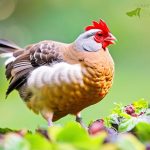Chickens are highly susceptible to heat stress, as they lack sweat glands and rely on panting to regulate their body temperature. When temperatures rise, chickens can quickly become overheated, leading to a range of health issues. Heat stress can cause decreased egg production, poor feed conversion, reduced growth rates, and even mortality in severe cases.
Additionally, heat stress can compromise the immune system of chickens, making them more susceptible to diseases. It’s important for poultry farmers to understand the impact of heat on their chickens in order to implement effective strategies to mitigate its effects. Heat stress in chickens can manifest in various ways, including panting, wing spreading, reduced activity, and decreased feed intake.
Chickens may also exhibit signs of distress such as drooping wings, pale combs and wattles, and even convulsions in severe cases. It’s crucial for farmers to be able to recognize these signs and take action to prevent further heat-related issues. Understanding the impact of heat on chickens also involves recognizing that different breeds may have varying levels of tolerance to heat.
For example, some breeds such as the Leghorn are more heat-tolerant, while others like the Silkie are more susceptible to heat stress. By understanding these differences, farmers can tailor their management practices to better support their chickens during periods of high temperatures.
Table of Contents
- 1 Providing adequate shade and ventilation
- 2 Ensuring access to cool, fresh water
- 3 Using cooling techniques such as misting or fans
- 4 Adjusting feeding schedules for cooler times of day
- 5 Monitoring for signs of heat stress and illness
- 6 Implementing additional measures for extreme heat events
- 7 FAQs
- 7.1 What are the signs of heat stress in chickens?
- 7.2 How can I keep my chickens cool in high heat?
- 7.3 What should I do if my chickens are showing signs of heat stress?
- 7.4 What are some ways to provide shade for chickens in high heat?
- 7.5 How often should I change the water for my chickens in high heat?
- 7.6 Can I give my chickens ice water to help them cool down?
Key Takeaways
- Heat can have a significant impact on chickens, leading to heat stress and decreased egg production.
- Providing adequate shade and ventilation is crucial to help chickens regulate their body temperature.
- Ensuring access to cool, fresh water is essential for keeping chickens hydrated and cool during hot weather.
- Using cooling techniques such as misting or fans can help lower the temperature in the chicken coop.
- Adjusting feeding schedules for cooler times of day can help reduce heat stress on chickens.
Providing adequate shade and ventilation
Shade and Ventilation in the Coop
One of the most important measures for preventing heat stress in chickens is to provide adequate shade and ventilation in their living environment. This can be achieved by ensuring that chicken coops and runs are situated in shaded areas, or by providing artificial shade such as tarps or shade cloth. Adequate ventilation is also crucial for allowing hot air to escape from the coop and fresh air to circulate. This can be achieved through the use of windows, vents, or fans to create airflow within the coop.
Reducing Ambient Temperature
By providing proper shade and ventilation, farmers can help to reduce the ambient temperature within the chicken coop and minimize the risk of heat stress. In addition to providing shade and ventilation within the coop, it’s important for farmers to consider the outdoor environment where chickens spend their time.
Creating a Comfortable Outdoor Environment
This may involve planting trees or shrubs to provide natural shade, or positioning coops in areas with natural windbreaks. Farmers should also be mindful of the time of day when heat is most intense and take measures to provide additional shade during these peak hours. By ensuring that chickens have access to shaded areas and good airflow, farmers can help to create a more comfortable living environment for their birds during hot weather.
Ensuring access to cool, fresh water

Access to cool, fresh water is essential for preventing heat stress in chickens. During periods of high temperatures, chickens will drink more water to help regulate their body temperature and stay hydrated. It’s important for farmers to ensure that water is readily available and that it remains cool throughout the day.
This may involve providing multiple water sources within the coop and run, as well as regularly refreshing water to keep it at a cool temperature. Farmers should also consider using insulated water containers or adding ice to waterers to help maintain cooler temperatures. In addition to providing cool water, farmers should also consider the placement of water sources within the coop and run.
Water should be positioned in shaded areas to prevent it from heating up in direct sunlight. Farmers should also monitor water consumption closely during hot weather and be prepared to increase the number of water sources if necessary. By ensuring that chickens have access to cool, fresh water at all times, farmers can help to prevent dehydration and reduce the risk of heat stress in their flock.
Using cooling techniques such as misting or fans
In addition to providing shade and ventilation, farmers can use various cooling techniques to help lower the ambient temperature within the chicken coop and run. One effective method is the use of misting systems, which release a fine spray of water into the air to help cool the surrounding environment. Misters can be installed within the coop or run, or positioned in outdoor areas where chickens spend time during hot weather.
Another option is the use of fans to create airflow and help lower the temperature within the coop. Fans can be strategically placed to promote air circulation and reduce heat buildup. Farmers should also consider using evaporative cooling methods such as wetting down the ground within the coop or run.
This can help to lower the ambient temperature by creating a cooling effect as water evaporates from the surface. Additionally, farmers can provide chickens with access to shallow pools or tubs of water for wading or soaking during extreme heat events. By using these cooling techniques, farmers can help to create a more comfortable environment for their chickens and reduce the risk of heat stress.
Adjusting feeding schedules for cooler times of day
During periods of high temperatures, it’s important for farmers to adjust feeding schedules to cooler times of day in order to reduce heat stress in chickens. Feeding chickens during the cooler morning or evening hours can help to minimize heat production from digestion and reduce the overall metabolic heat load on the birds. Farmers should also consider providing smaller, more frequent meals during hot weather to help prevent overeating and reduce metabolic heat production.
In addition to adjusting feeding schedules, farmers should also consider modifying the composition of chicken feed during hot weather. This may involve reducing the protein content of feed, as protein digestion produces more metabolic heat compared to carbohydrates or fats. Farmers should also ensure that feed is stored in a cool, dry place to prevent spoilage and maintain its nutritional quality during hot weather.
By adjusting feeding schedules and feed composition, farmers can help to reduce the risk of heat stress in their flock and support their chickens’ overall well-being during periods of high temperatures.
Monitoring for signs of heat stress and illness

Recognizing the Signs of Heat Stress
Farmers should be aware of indicators such as panting, wing spreading, reduced activity, and decreased feed intake, as well as more severe signs like drooping wings, pale combs and wattles, or convulsions. They should also be vigilant for any signs of illness that may be exacerbated by heat stress, such as respiratory infections or heat-related diseases.
Proactive Monitoring and Intervention
In addition to visual monitoring, farmers should take chickens’ body temperatures using a thermometer if necessary. This helps identify individual birds experiencing heat stress and requiring immediate attention. If any signs of heat stress or illness are observed, farmers should take action, such as moving chickens to a cooler area, providing additional shade or ventilation, or seeking veterinary care if necessary.
Preventing Health Issues and Supporting Well-being
By monitoring for signs of heat stress and illness, farmers can take proactive measures to prevent further health issues and support their chickens’ well-being during hot weather.
Implementing additional measures for extreme heat events
In extreme heat events, it may be necessary for farmers to implement additional measures to protect their chickens from heat stress. This may involve temporarily relocating chickens to a cooler area such as a barn or shaded structure, or providing access to air-conditioned spaces if available. Farmers should also consider using emergency cooling methods such as wetting down the ground within the coop or run more frequently, or providing additional misting or fans to help lower the ambient temperature.
In addition to these measures, farmers should be prepared to adjust their management practices during extreme heat events in order to minimize stress on their flock. This may involve reducing handling and other stressful activities, as well as closely monitoring water consumption and overall chicken behavior for any signs of distress. Farmers should also be prepared with a contingency plan in case of power outages or other emergencies that may impact their ability to provide adequate shade, ventilation, and cooling for their chickens.
By implementing additional measures for extreme heat events, farmers can help to protect their flock from the potentially devastating effects of heat stress and ensure their well-being during periods of extreme temperatures. In conclusion, understanding the impact of heat on chickens is crucial for poultry farmers in order to implement effective strategies for preventing heat stress and supporting their flock’s well-being during hot weather. By providing adequate shade and ventilation, ensuring access to cool, fresh water, using cooling techniques such as misting or fans, adjusting feeding schedules for cooler times of day, monitoring for signs of heat stress and illness, and implementing additional measures for extreme heat events, farmers can help to mitigate the effects of high temperatures on their chickens and promote a healthy living environment for their flock.
It’s important for farmers to be proactive in managing heat stress in their chickens in order to prevent health issues and maintain optimal productivity and overall well-being in their flock.
If you’re looking for tips on how to keep chickens cool in high heat, you may also be interested in learning about the Producers Pride Sentinel Chicken Coop. This coop is designed to provide a comfortable and safe environment for your chickens, which is especially important during hot weather. Check out this article to learn more about this innovative coop and how it can help keep your chickens cool and comfortable.
FAQs
What are the signs of heat stress in chickens?
Signs of heat stress in chickens include panting, holding their wings away from their bodies, decreased egg production, lethargy, and loss of appetite.
How can I keep my chickens cool in high heat?
You can keep your chickens cool in high heat by providing plenty of shade, ensuring good ventilation in the coop, offering cool water to drink, and using misters or fans to lower the temperature.
What should I do if my chickens are showing signs of heat stress?
If your chickens are showing signs of heat stress, move them to a cooler area with shade and provide them with cool water to drink. You can also use fans or misters to help lower the temperature.
What are some ways to provide shade for chickens in high heat?
You can provide shade for chickens in high heat by using tarps or shade cloths to cover their coop and run, planting trees or shrubs for natural shade, or setting up umbrellas or awnings in their outdoor area.
How often should I change the water for my chickens in high heat?
In high heat, you should change the water for your chickens at least once a day to ensure it stays cool and clean. If the temperature is extremely high, you may need to change the water more frequently.
Can I give my chickens ice water to help them cool down?
Yes, you can give your chickens ice water to help them cool down. However, make sure the water is not too cold, as extreme temperature changes can be harmful to chickens.
Meet Walter, the feathered-friend fanatic of Florida! Nestled in the sunshine state, Walter struts through life with his feathered companions, clucking his way to happiness. With a coop that’s fancier than a five-star hotel, he’s the Don Juan of the chicken world. When he’s not teaching his hens to do the cha-cha, you’ll find him in a heated debate with his prized rooster, Sir Clucks-a-Lot. Walter’s poultry passion is no yolk; he’s the sunny-side-up guy you never knew you needed in your flock of friends!







